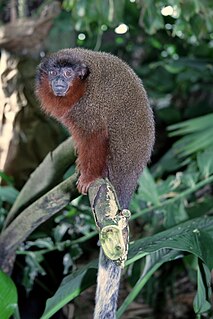
The brown titi, Plecturocebus brunneus, is a species of titi, a type of New World monkey, from South America. It is found in Brazil, Peru, and Bolivia. It was originally described as Callicebus brunneus in 1842.

The brown catshark is commonly found in the Pacific Ocean, ranging from the northern Pacific waters off the coast of British Columbia and south to the Baja California peninsula in Mexico. They may live as far south as Ecuador and Peru. Brown catsharks are deep-water sharks that live on the outer continental shelf and the upper slope. They have been known to live at depths ranging from 30 to 650 m and live on the bottom, usually in muddy or sandy areas. The brown catshark, when originally described, was called Catulus brunneus.
Zygodontomys brunneus, also known as the brown zygodont, brown cane mouse, or Colombian cane mouse, is a rodent species in the genus Zygodontomys of tribe Oryzomyini. It is found only in Colombia.

Lamiini is a tribe of longhorn beetles of the subfamily Lamiinae.

Hammatoderus is a genus of longhorn beetles of the subfamily Lamiinae, containing the following species:

Hammatoderus lunaris is a species of beetle in the family Cerambycidae. It was described by Henry Walter Bates in 1880. It is known from Mexico.

Hammatoderus maculosus is a species of beetle in the family Cerambycidae. It was described by Henry Walter Bates in 1880. It is known from Guatemala, El Salvador, Mexico, Honduras, Belize, and Nicaragua.
Hammatoderus thiodes is a species of beetle in the family Cerambycidae. It was described by Henry Walter Bates in 1880. It is known from Panama and Costa Rica.
Hammatoderus granulosus is a species of beetle in the family Cerambycidae. It was described by Henry Walter Bates in 1885. It is known from Mexico and Belize.
Hammatoderus laceratus is a species of beetle in the family Cerambycidae. It was described by Henry Walter Bates in 1885. It is known from Mexico.
Hammatoderus ornator is a species of beetle in the family Cerambycidae. It was described by Henry Walter Bates in 1885. It is known to exist in Mexico.
Hammatoderus elatus is a species of beetle in the family Cerambycidae. It was described by Henry Walter Bates in 1872. It is known from Mexico, Costa Rica, Ecuador, Colombia, Honduras, Panama, and Nicaragua.
Hammatoderus nitidus is a species of beetle in the family Cerambycidae. It was described by Henry Walter Bates in 1874. It is known from Nicaragua.

Hammatoderus inermis is a species of beetle in the family Cerambycidae. It was described by James Thomson in 1857. It is known from Nicaragua and Mexico.
Hammatoderus lacordairei is a species of beetle in the family Cerambycidae. It was described by James Thomson in 1860. It is known from Panama and Mexico.
Hammatoderus confusor is a species of beetle in the family Cerambycidae. It was described by Dillon and Dillon in 1941. It is known from Brazil, Bolivia, and Paraguay.
Hammatoderus olivescens is a species of beetle in the family Cerambycidae. It was described by Dillon and Dillon in 1941. It is known from Mexico and Costa Rica.
Hammatoderus emanon is a species of beetle in the family Cerambycidae. It is known from Nicaragua, Costa Rica, and Panama. It was originally described by Dillon and Dillon in 1941 as Plagiohammus emanon, but later combined into the genus Hammatoderus, thus making the current binomial name Hammatoderus emanon.
Hammatoderus colombiensis is a species of beetle in the family Cerambycidae. It was described by Constantino, Benavides and Esteban in 2014. It is known from Colombia.

Hammatoderus thoracicus is a species of beetle in the family Cerambycidae. It was described by White in 1858. It is known from Mexico, Costa Rica, Guatemala, Panama, Honduras, Colombia, Nicaragua, Peru, El Salvador, and Venezuela.







